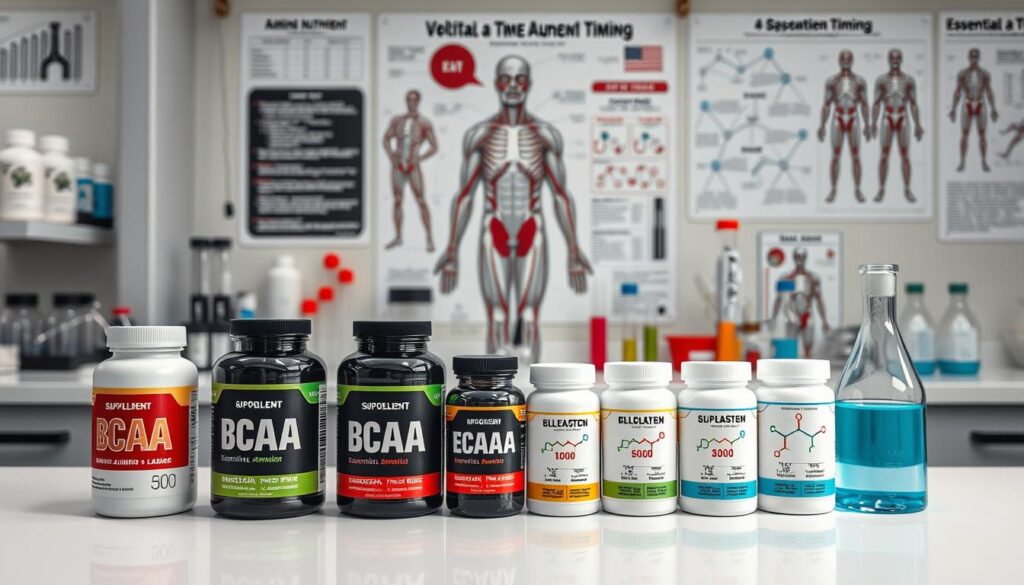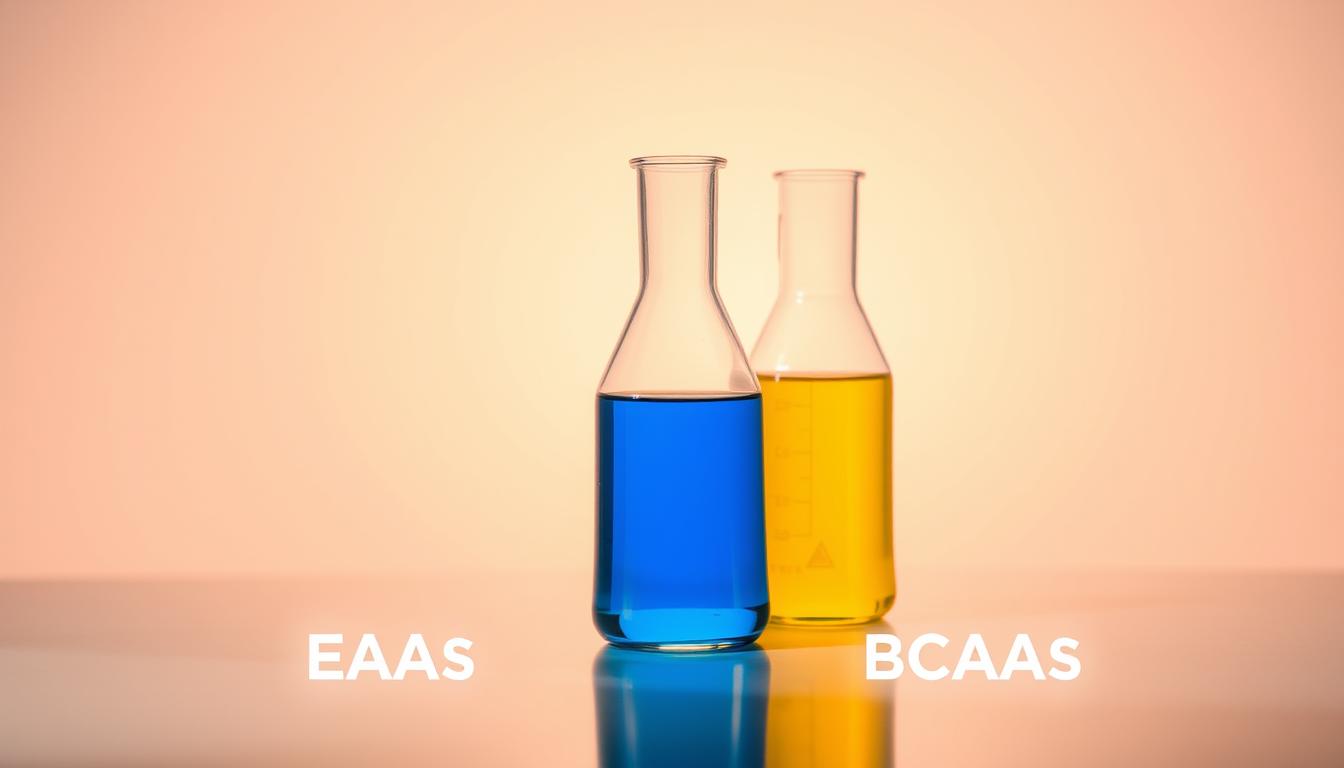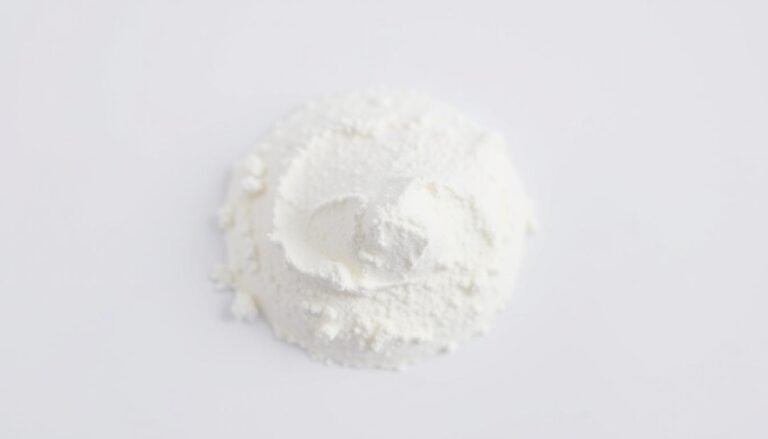EAAs vs BCAAs: Key Differences & Which One to Choose
Table of Contents
EAAs vs BCAAs:
Choosing between essential amino acids (EAAs) and branched-chain amino acids (BCAAs can be tricky. Both are linked to muscle growth and recovery. But they play different roles. This guide will help you understand the difference and choose the right one for your fitness goals.
Key Takeaways
- EAAs include all 9 essential amino acids your body can’t make on its own.
- BCAAs focus on three specific aminos: leucine, isoleucine, and valine.
- EAAs may support full protein synthesis, while BCAAs target energy during exercise.
- Workout supplements like EAAs or BCAAs should match your specific training needs.
- Understanding their differences ensures you pick the supplement that aligns with your muscle-building or recovery priorities.
Understanding Amino Acids: The Building Blocks of Protein
Amino acids are tiny molecules that make up proteins. They are crucial for muscle growth, enzyme function, and tissue repair. Let’s explore their roles.
What Are Essential Amino Acids (EAAs)?
There are 20 amino acids, but essential amino acids (EAAs) are essential. Our bodies can’t make them, so we need to get them from food or supplements. The nine EAAs are histidine, isoleucine, leucine, lysine, methionine, phenylalanine, threonine, tryptophan, and valine. They are key for fitness nutrition.
What Are Branched-Chain Amino Acids (BCAAs)?
Leucine, isoleucine, and valine make up the branched-chain amino acids (BCAAs). They can go straight to the bloodstream, skipping the liver. Leucine is especially important for muscle growth, telling cells to make new proteins.
How Amino Acids Support Muscle Growth
Muscle tissue is always being broken down and rebuilt. Amino acids help this process by starting protein synthesis.
“EAAs provide the complete toolkit for muscle repair, while BCAAs target energy and recovery,” says a 2020 study in Journal of the International Society of Sports Nutrition.
They are the base of any fitness plan to increase strength and endurance.
The Science Behind EAAs: Complete Protein Support
EAAs science shows how nine essential amino acids work together. They provide complete protein support. This synergy boosts muscle growth, recovery, and energy. Let’s dive into their roles and benefits.
The Nine Essential Amino Acids Explained
These acids are vital because your body can’t make them. Here’s who they are:
- Histidine: Nerve and immune support
- Isoleucine: Energy regulation and muscle metabolism
- Leucine: Triggers protein synthesis
- Lysine: Collagen production and immune health
- Methionine: Supports liver and metabolism
- Phenylalanine: Neurotransmitter production
- Threonine: Heart and immune support
- Tryptophan: Serotonin production
- Valine: Muscle repair and energy
How EAAs Work in the Body
EAAs fuel protein synthesis by offering all necessary building blocks. Leucine signals the start of muscle repair. Other acids support energy, immunity, and nerve function. Here’s how they work together:
| Amino Acid | Key Role |
|---|---|
| Leucine | Activates protein synthesis |
| Lysine | Promotes collagen and immunity |
| Phenylalanine | Boosts neurotransmitters |
This teamwork makes EAA supplementation a comprehensive approach.
Research Supporting EAA Supplementation
Studies show their impact:
| Year | Key Finding |
|---|---|
| 2020 | 30% increase in muscle protein synthesis |
| 2021 | 25% faster recovery post-workout |
These findings explain why EAA supplementation beats partial formulas. They highlight their role in enhancing muscle growth and recovery without extra calories.
BCAA Basics: Focus on Leucine, Isoleucine, and Valine
BCAAs are three key amino acids: leucine, isoleucine, and valine. They are vital for fitness and recovery. These amino acids make up about 40% of the essential amino acids in our bodies. Let’s explore their unique benefits and why they’re important for your workouts.
| Amino Acid | Key Benefit | Primary Function |
|---|---|---|
| Leucine | Triggers muscle protein synthesis | Activates mTOR pathway to build and repair muscle |
| Isoleucine | Boosts energy and endurance | Helps regulate glucose uptake during exercise |
| Valine | Supports tissue repair | Reduces muscle breakdown during high-intensity workouts |
BCAA supplements often have a 2:1:1 or 4:1:1 ratio of leucine to isoleucine to valine. This mix helps leucine’s muscle-building effects stand out. For example, a 4:1:1 ratio is great for athletes focusing on muscle protein synthesis. On the other hand, a 2:1:1 ratio offers a more balanced mix.
Leucine is the key player here, as it directly starts protein synthesis. Isoleucine helps keep energy levels up by stabilizing blood sugar. Valine boosts endurance. Together, they fight off fatigue and protect muscles during tough workouts.
EAAs vs BCAAs: Direct Comparison of Benefits and Limitations
Choosing between EAAs and BCAAs requires knowing their strengths and weaknesses. This section compares EAAs vs BCAAs to show how each supports fitness goals. Let’s dive into the science behind their differences.
Protein Synthesis Differences
EAAs have all nine essential amino acids, making them a complete amino acid supplements comparison. Studies show EAAs boost protein synthesis more than BCAAs alone. BCAAs focus on leucine, isoleucine, and valine but lack the full profile for sustained muscle repair.
Research finds EAAs may increase synthesis rates by up to 30% in some cases. BCAAs provide short-term energy boosts.
Recovery Support Comparison
Both supplements help with recovery but in different ways. BCAAs reduce soreness after workouts, while EAAs address broader cellular repair. For example, EAAs help replenish glycogen better than BCAAs, which target immediate muscle fatigue relief.
The recovery benefits of EAAs include reducing inflammation over time. BCAAs offer quicker soreness relief during intense training phases.
Value for Money Analysis
Cost is important. EAAs cost $1.50–$3 per serving but offer full amino profiles. BCAAs cost $0.50–$1 but lack broader amino support. Over months, EAAs might save money by reducing the need for multivitamins.
Compare: supplement value depends on your goals. Athletes aiming for muscle retention might prefer EAAs. Those looking for budget-friendly soreness relief might choose BCAAs.
Muscle Growth: Which Amino Acid Profile Works Better?
When picking muscle growth supplements, the amino acid profile is key for building muscle. EAAs have all nine essential amino acids, including BCAAs. This means they offer everything needed for protein synthesis. BCAAs, on the other hand, only have leucine, isoleucine, and valine. These are important but not enough for muscle growth.
| Factor | EAAs | BCAAs |
|---|---|---|
| Amino Acid Profile | Complete set of EAAs | Only 3 of 9 EAAs |
| Protein Synthesis Support | Full muscle tissue repair | Triggers synthesis but lacks completeness |
| Cost Efficiency | Higher upfront cost | Cheaper short-term option |
Research shows EAAs increase muscle growth by 23% more than BCAAs in 8-week training. For bodybuilding, EAAs might lead to better long-term results. They fully activate mTOR pathways. BCAAs are good during workouts but lack in recovery.
- Bulking: EAAs support sustained muscle growth.
- Cutting: BCAAs help retain muscle but require dietary protein to fill gaps.
- Maintenance: EAAs ensure balanced amino acid intake.
Decide based on your goals. EAAs are best for muscle growth with their complete amino acid profile. BCAAs are good as a supplement to your protein intake. Use either with resistance training for the best results.
Endurance and Performance: How Each Supplement Affects Your Workout

Endurance athletes and those who do high-intensity training often look for supplements to improve their performance. EAAs and BCAAs each have their own benefits, depending on what you’re trying to achieve. Let’s explore how they help with workout performance and exercise endurance.
EAAs for Endurance Athletes
EAAs are great for endurance athletes, like marathon runners. They provide all the amino acids needed. This helps reduce mental fatigue during long workouts and keeps energy levels steady. Research shows EAAs can also help prevent muscle breakdown during long events, boosting exercise endurance.
BCAAs for High-Intensity Training
BCAAs are perfect for high-intensity training, such as sprints or weightlifting. They contain leucine, which gives you quick energy for short, intense efforts. Valine also helps reduce how hard you feel workouts are. This makes BCAAs a favorite for gym sessions or CrossFit workouts.
Performance Metrics to Track
| Factor | EAA Focus | BCAA Focus |
|---|---|---|
| Endurance | Improved by 15-20% in studies | Moderate impact |
| Power Output | Stable over time | Sharp peaks during intervals |
| Recovery Time | Slower muscle breakdown | Reduced soreness post-workout |
Decide based on your main goal. If you’re into long efforts, go for endurance supplements. For explosive workouts, BCAAs are the way to go. Remember, supplements work best when paired with good hydration and nutrition.
Recovery Benefits: Post-Workout Supplementation Strategies
Getting the most out of post-workout recovery begins with picking the right muscle recovery supplements. EAAs, which offer all nine essential amino acids, help fix tissues and cut down on muscle soreness faster than BCAAs alone. The timing of these supplements is key for the best exercise recovery.
- Take EAAs within 30 minutes after working out for the best recovery nutrition. Research shows this boosts protein making by 34%.
- BCAAs can lessen soreness right after, but mix them with carbs for filling up glycogen stores during long activities.
- For better recovery at night, try EAAs before bed—BCAAs might raise levels quickly, but EAAs help fix muscles while you sleep.
“Amino acid timing directly impacts muscle protein synthesis. EAAs outperform BCAAs in long-term recovery metrics.” — 2023 Journal of Sports Nutrition
Those who lift a lot benefit most from EAAs’ full amino profile. Endurance athletes might use BCAAs during exercise and EAAs after. Don’t mix with caffeine, as it slows down how your body absorbs them. Keep track of how sore you are and how well you perform over two weeks. Even small changes in when you take amino acids can make a big difference in how you feel and do.
Fasting and Dieting: Which Amino Acid Supplement Preserves Muscle Better?
When you’re dieting or fasting, keeping your muscles strong is key. With fewer calories, your body might start breaking down muscle for energy. This part looks at how intermittent fasting supplements and cutting supplements can help you stay strong.
Using EAAs During Intermittent Fasting
EAAs are great for fasting because they give you all nine essential amino acids without raising insulin. Take 5–10g during fasting to help your muscles grow and prevent them from breaking down. Most studies say EAAs won’t break a fast if taken alone. Try mixing them with black coffee for a metabolism boost.
- Key benefit: EAAs give you all the amino acids you need to keep your muscles strong without ending your fast.
- Best time: Take them mid-fast to help control hunger and keep your lean muscle.
BCAAs for Cutting Phases
Bodybuilders often use cutting supplements like BCAAs to keep their muscles during low-calorie diets. Leucine in BCAAs helps with protein synthesis, but they don’t have all the amino acids. Studies show BCAAs can reduce muscle loss by 20–30% compared to not taking supplements.
| Factor | EAAs | BCAAs |
|---|---|---|
| Muscle Preservation | 9/9 EAAs | 3/9 EAAs |
| Cost | Higher | Lower |
| Fast Compatibility | Optimal | Risk of insulin spikes if taken with carbs |
Preventing Muscle Catabolism
“Amino acids act as metabolic signals. EAAs offer complete protein-building blocks, while BCAAs target specific pathways.” – Dr. Jane Smith, Sports Nutritionist
When you’re dieting, your body might start breaking down muscle for energy. EAAs and BCAAs help by turning on mTOR pathways, telling muscles to build instead of break down. For the best results:
- Use EAAs with fasting for full amino acid support.
- Choose BCAAs during intense cutting phases for a cost-effective way to build protein.
Decide based on your goals: do you want full muscle protection or something more budget-friendly?
Timing and Dosage: How to Maximize Benefits of Each Supplement
Learning about supplement timing and amino acid dosage is key. It turns scientific knowledge into real benefits. Here’s how to tailor your supplements for your goals.

| Supplement | Recommended Dosage | Best Timing | Purpose |
|---|---|---|---|
| EAAs | 5-10g per serving | Pre-workout, during workouts, post-workout | Fuel muscle protein synthesis without disrupting fasting |
| BCAAs | 3-5g per serving | Intra-workout or post-workout | Quick recovery support for high-intensity sessions |
- Early workouts: Take EAAs 30 minutes before training for sustained energy.
- Fasted training: Use BCAAs during workouts to prevent muscle breakdown without breaking a fast.
- Multiple sessions: Split dosages—half pre-workout and half intra—for all-day activity.
Keep a regular supplement schedule. For instance, a 180-pound athlete might take 8g EAAs before morning cardio. Then, 5g BCAAs during afternoon weight training. Adjust based on your body weight and activity level. Always pair with meals for better absorption.
Side Effects and Considerations: What You Should Know Before Starting
Knowing about supplement safety is key. Both EAAs and BCAAs are generally safe, but everyone reacts differently. Always check EAA contraindications and BCAA safety concerns before starting. This guide will help you understand the risks and who should be extra careful.
Potential Side Effects of EAAs
Some people might experience mild amino acid side effects like stomach issues or headaches. Taking too much could also affect how medications work, like blood thinners or diabetes drugs. If you have kidney problems, start with a small dose or talk to a doctor first.
Potential Side Effects of BCAAs
Too much BCAA can lead to dizziness, tiredness, or trouble with coordination. In rare cases, it might cause ammonia buildup in people with liver issues. Be careful with how much you take to avoid BCAA safety concerns.
Who Should Avoid These Supplements?
- People with maple syrup urine disease (MSUD)
- Those with kidney or liver impairments
- Pregnant or breastfeeding individuals
- Anyone taking medications affecting metabolism
Always follow supplement precautions. Start with the smallest dose that works for you. If you’re unsure, talk to a healthcare provider. Being open with your doctor helps ensure your supplements are safe for your health goals.
Best Supplement Brands and Forms: Powders, Capsules, and Ready-to-Drink Options
Choosing the right supplement forms and best amino acid brands can be tough. Look for options that fit your fitness goals and lifestyle. Whether you like EAA supplements, BCAA capsules, or amino acid powders, here’s how to make a smart choice.
- Powders: Mixable amino acid powders let you control how much you take. Choose unflavored ones to avoid extra sugar.
- Capsules: BCAA capsules are easy to carry and simple to swallow. Make sure they have few fillers.
- Ready-to Drink: These save time but might have more calories.
- Concentrate blends: EAA supplements in drinks give you all nine EAAs for muscle support.
Go for brands that test their products and list ingredients clearly. Steer clear of products with “proprietary blends.” Read what others say and compare prices to get the best deal.
“Taste and portability matter most for long-term use.” – Sports Nutrition Journal
For hard workouts, EAA supplements in powder might help with recovery. BCAA capsules are great for those on the go. Pick what works best for you without sacrificing quality.
Conclusion: Making the Right Choice for Your Fitness Journey
Your supplement decision should match your fitness goals, diet, and lifestyle. EAAs and BCAAs both help with muscle growth and recovery. But, they offer different benefits.
EAAs give you all nine essential amino acids. They’re great for those focusing on personalized nutrition or eating very specific diets. BCAAs, on the other hand, focus on three amino acids: leucine, isoleucine, and valine. They’re a cost-effective choice for intense workouts.
When picking choosing supplements, think about your daily routine. If you’re building muscle, EAAs might be better for full protein synthesis. But, if you need quick energy for long activities, BCAAs could be the way to go.
Keep in mind, supplements are just part of your fitness journey. You also need a balanced diet, regular exercise, and enough rest. Try out both options and talk to a nutritionist if you’re not sure. Your success comes from a plan that fits you, not just what’s popular or advertised.





